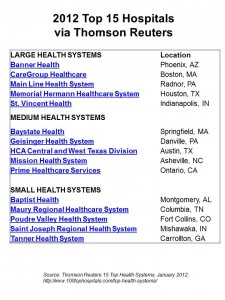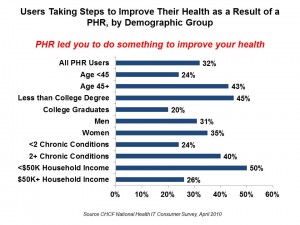 Congrats to the 2012 Top 15 Health Systems as crowned by Thomson Reuters today, shown in the chart. They are segmented by size, with large systems (>$1.5 bn), medium ($750mm – $1.5 bn), and small (<$750 mm). No matter their size, though, across the segments, these best hospitals share several traits:
Congrats to the 2012 Top 15 Health Systems as crowned by Thomson Reuters today, shown in the chart. They are segmented by size, with large systems (>$1.5 bn), medium ($750mm – $1.5 bn), and small (<$750 mm). No matter their size, though, across the segments, these best hospitals share several traits:
- They demonstrate better patient outcomes in terms of better survival rates and fewer complications
- Better long-term outcomes
- They adopt evidence-based medicine
- They have better patient safety track records
- Their patients leave hospital sooner, which could result in the fact that
- Patients are more satisfied than consumers at other hospitals (with higher HCAHPS scores).
To accomplish these outcomes, all 15 have strong health IT infrastructures.
Health Populi’s Hot Points: I’ve studied the “Healthcare’s Most Wired” Health Providers from Hospitals & Health Networks and the Thomson Reuters Top 100 Hospitals for many years. It strikes me in 2012 that with meaningful use and patient engagement on the front-burner for providers adopting EHRs that a useful metric for these studies could be patient engagement.
 This could take the form of percent of patients who request and receive a copy of their EHR; or, percent of patients who take advantage of patient portals or personal health records. We know from a survey conducted by the California HealthCare Foundation in 2010 that the more patients engage with their health information in a PHR, the more likely they are to ask questions of their providers and more deeply participate in their health care. The second chart illustrates this phenomenon.
This could take the form of percent of patients who request and receive a copy of their EHR; or, percent of patients who take advantage of patient portals or personal health records. We know from a survey conducted by the California HealthCare Foundation in 2010 that the more patients engage with their health information in a PHR, the more likely they are to ask questions of their providers and more deeply participate in their health care. The second chart illustrates this phenomenon.
And, greater engagement leads to better outcomes.
On a personal note, congratulations to ‘my’ personal health system, Main Line Health, where my doctors use an EHR, partner with me, and welcome my participation in my own care.




 Interviewed live on BNN Bloomberg (Canada) on the market for GLP-1 drugs for weight loss and their impact on both the health care system and consumer goods and services -- notably, food, nutrition, retail health, gyms, and other sectors.
Interviewed live on BNN Bloomberg (Canada) on the market for GLP-1 drugs for weight loss and their impact on both the health care system and consumer goods and services -- notably, food, nutrition, retail health, gyms, and other sectors. Thank you, Feedspot, for
Thank you, Feedspot, for  As you may know, I have been splitting work- and living-time between the U.S. and the E.U., most recently living in and working from Brussels. In the month of September 2024, I'll be splitting time between London and other parts of the U.K., and Italy where I'll be working with clients on consumer health, self-care and home care focused on food-as-medicine, digital health, business and scenario planning for the future...
As you may know, I have been splitting work- and living-time between the U.S. and the E.U., most recently living in and working from Brussels. In the month of September 2024, I'll be splitting time between London and other parts of the U.K., and Italy where I'll be working with clients on consumer health, self-care and home care focused on food-as-medicine, digital health, business and scenario planning for the future...